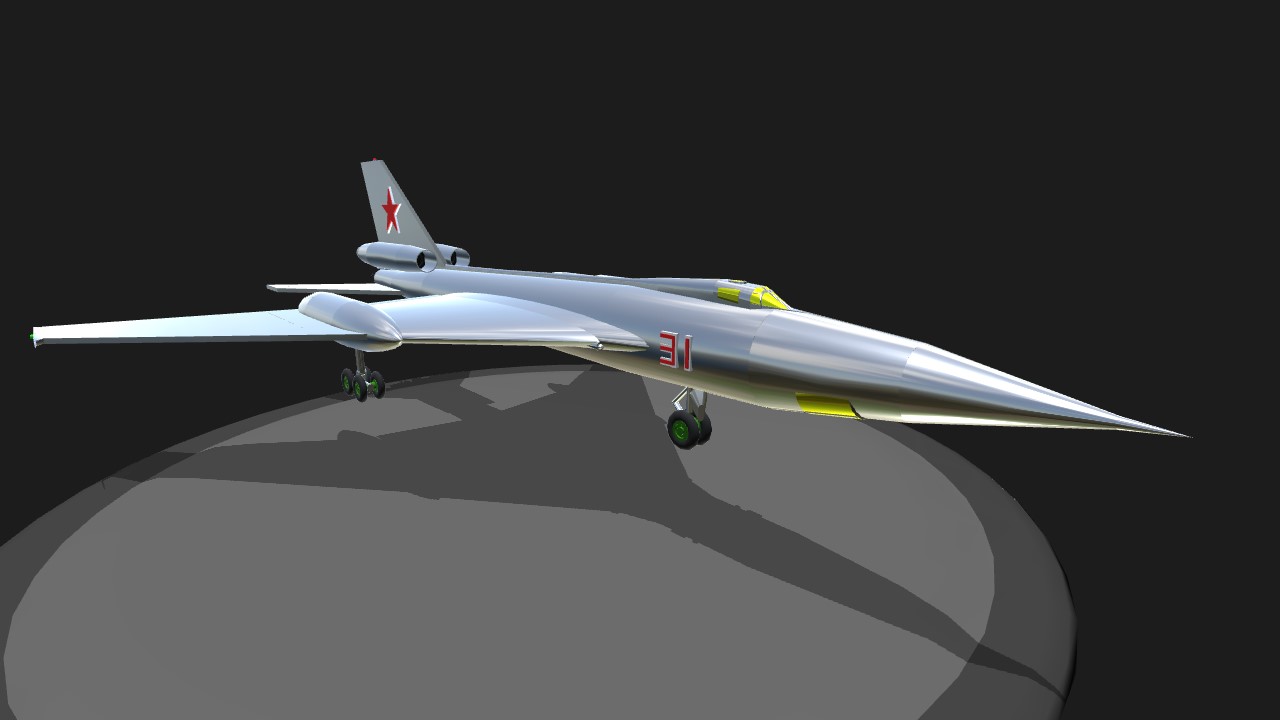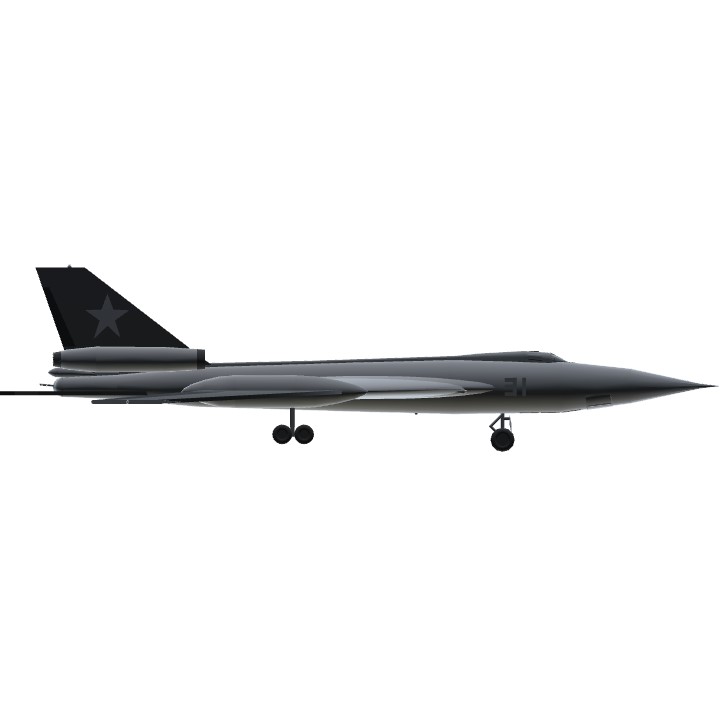( English version at the bottom of the page )
Les origines du Tu-22 remontent aux années cinquante, lorsque les bureaux d’études de Tupolev et Iliouchine commencèrent
à étudier le développement de bombardiers stratégiques supersoniques en réponse au Convair B-58 Hustler américain.
Dans l’inventaire soviétique, le nouvel appareil était prévu pour le remplacement des Tupolev Tu-16 Badger.
Pour répondre à la demande officielle portant sur un bombardier supersonique, Tupolev proposa au milieu des années 1950
un tout nouveau modèle, désigné Projet 105. La production des appareils de présérie débuta en 1960 et l’Union Soviétique put
présenter au monde, lors de la grande parade aérienne de Tushino le 9 juillet 1961, le Tupolev Tu-22B. Il sera baptisé Blinder par l’OTAN.
L’apparition du Tu-22 causa une certaine émotion aux militaires occidentaux, tant son apparence était peu conventionnelle
Loin des lourds bombardiers produits jusqu’alors, le Tu-22 avait une allure futuriste, avec une aérodynamique particulièrement
soignée, clairement destinée à donner la plus grande vitesse possible au nouveau bombardier. De gros efforts furent consentis
pour intégrer au mieux la soute à bombes, le train d’atterrissage et le poste de pilotage. Cette recherche de la vitesse
correspondait à un choix clair, favoriser la vitesse au détriment de la charge emportée, afin de percer les défenses des états occidentaux.
Doté d’une voilure en flèche à 55°, le Tu-22 présentait également une configuration moteur inédite, ses deux réacteurs étant
placés non sous les ailes mais à l’arrière du fuselage, à la base de la dérive. Cela permit d’accroître la capacité de carburant
transportée et le rendement des moteurs. Derrière l’habitacle pressurisé, on trouve un grand réservoir interne.
Au niveau de l’armement, tous les Blinder étaient armés d’un (parfois deux) canon de 23 mm en tourelle de queue, et étaient en
capacité de transporter 9 tonnes de bombes, en général des FAB-500 non guidées de 500 kilos chacune. Pour remplir leurs
missions, les Tu-22B disposaient d’un système de navigation et d’attaque Rubin-A. Les versions dédiées à la reconnaissanc
reçurent des caméras et des équipements de surveillance électronique. On connaît une dizaine de versions du Tu-22, dont on
citera ici les principales.
Versions principales :
Tu-22B (Blinder-A) : version destinée au bombardement, seuls 15 exemplaires produits .
Tu-22K (Blinder-B) : dédiée à la lutte antinavire, avec un unique missile AS-4 Kitchen/Kh-22 sous le
fuselage, 4 sous-versions connues (K, KD, KP et KPD) ; 150 exemplaires produits .Tu-22R (Blinder-C) : dédiée à la reconnaissance, 5 sous-versions connues (R, RD, RK, RDK et RDM) ; 127 exemplaires
produits, la moitié pour l’aéronavale soviétique .Tu-22U (Blinder-D) : dédiée à l’entraînement, avec un étonnant deuxième cockpit surélévé, 2 sous-versions
connues (U et UD ) ; 47 exemplaires produits .Tu-22P (Blinder-E) : dédiée à la guerre électronique et aux missions ELINT, 2 sous-versions
connues (P et PD) ; 47 exemplaires produits .Tu-22KP : dédiée à la guerre électronique et à la lutte antiradar (équipé pour cela d’un Kh-22P) .
Il est à noter que les dénominations incluant la lettre D sont des versions équipées d’une perche de ravitaillement en vol.
Malgré ses qualités, le Tu-22 fut une déception. Le Tu-22B de bombardement était inférieur par bien des aspects au Tu-16, qu’il
était censé remplacer. Le cockpit n’était pas du tout réussi : la visibilité était médiocre, l’agencement des commandes mal fichu
et les équipages se plaignèrent que leurs sièges n’étaient pas confortables, ce qui risquait de poser quelques problèmes lors de
vols à longue distance. Vols de toute façon compromis par l’autonomie réduite du Tu-22 : 4900 kilomètres à vide, vite réduits
par l’emport d’une charge. Dès les années 1980, le Tu-22 n’avait plus qu’une valeur militaire limitée, ce qui permit son exportation.
Le Tu-22 fut en effet employé à plusieurs reprises au combat. Les Soviétiques engagèrent leurs appareils en Afghanistan
dans des missions de bombardement. A la chute de l’URSS, il semble que seule une centaine de Blinder restait en
service, la plupart d’entre eux ayant été évincés par le Tu-22M Backfire plus moderne.
A l’heure actuelle, il ne reste plus qu’une poignée d’appareils en service en Russie, utilisés pour la reconnaissance.
Vitesse de décollage : environ 300 Mph . Décollage Trim et volets a fonds . Vitesse de croisiére max 1200 Mph .
Correction au palonnier au décollage . Correction Trim pendant le vol .
- Réacteur : touche 1 2 .
- Feux de navigation : touche 3 .
- Feu d'atterrissage : touche 4 .
- Parachute : touche 5 .
- Volets : Vtol bas .
- Trim : Trim .
English version .
The origins of the Tu-22 date back to the 1950s, when the Tupolev and Iliouchine design offices began
to study the development of supersonic strategic bombers in response to the American Convair B-58 Hustler.
In the Soviet inventory, the new device was intended for the replacement of Tupolev Tu-16 Badger.
To respond to the official request for a supersonic bomber, Tupolev proposed in the mid-1950s
a brand new model, designated Project 105. Production of pre-production units began in 1960 and the Soviet Union was able to
to present to the world, during the great Tushino air parade on July 9, 1961, Tupolev Tu-22B. It will be named Blinder by NATO.
The appearance of the Tu-22 caused some emotion to the Western military, as its appearance was unconventional
Far from the heavy bombers produced until then, the Tu-22 had a futuristic look, with particularly aerodynamic
neat, clearly intended to give the maximum speed possible to the new bomber. Great efforts were made
to better integrate the bomb bay, the landing gear and the cockpit. This search for speed
corresponded to a clear choice, to favor the speed to the detriment of the carried load, in order to pierce the defenses of the western states.
Equipped with a 55 ° boom, the Tu-22 also had a unique engine configuration, its two engines being
placed not under the wings but at the rear of the fuselage, at the base of the drift. This increased the fuel capacity
transported and engine performance. Behind the pressurized cabin, there is a large internal tank.
At the level of armament, all Blinder were armed with one (sometimes two) 23 mm cannon turret, and were
capacity to carry 9 tons of bombs, usually unguided FAB-500 of 500 kilos each. To fill their
missions, the Tu-22B had a Rubin-A navigation and attack system. The versions dedicated to recognition
received cameras and electronic surveillance equipment. We know about ten versions of the Tu-22, which we
here will be the main ones.
Main versions:
Tu-22B (Blinder-A): version intended for the bombardment, only 15 copies produced.
Tu-22K (Blinder-B): dedicated to the anti-ship fight, with a single AS-4 Kitchen / Kh-22 missile under the
fuselage, 4 known sub-versions (K, KD, KP and KPD); 150 copies produced.Tu-22R (Blinder-C): dedicated to recognition, 5 known sub-versions (R, RD, RK, RDK and RDM); 127 copies
products, half for Soviet naval aviation.Tu-22U (Blinder-D): dedicated to training, with an amazing second raised cockpit, 2 sub-versions
known (U and UD); 47 copies produced.Tu-22P (Blinder-E): dedicated to electronic warfare and ELINT missions, 2 sub-versions
known (P and PD); 47 copies produced.Tu-22KP: dedicated to the electronic warfare and to the fight against radiation (equipped for that with a Kh-22P).
It should be noted that the denominations including the letter D are versions equipped with an in-flight refueling boom.
Despite its qualities, the Tu-22 was a disappointment. The bombing Tu-22B was inferior in many respects to Tu-16, which he
was supposed to replace. The cockpit was not at all successful: the visibility was poor, the layout of the orders badly done
and the crews complained that their seats were not comfortable, which might pose some problems when
long-distance flights. Flights anyway compromised by the reduced autonomy of Tu-22: 4900 kilometers empty, quickly reduced
by carrying a load. By the 1980s, the Tu-22 had only limited military value, which allowed its export.
Tu-22 was used repeatedly in combat. The Soviets engaged their aircraft in Afghanistan
in bombing missions. At the fall of the USSR, it seems that only a hundred of Blinder remained in
service, most of them having been ousted by the more modern Tu-22M Backfire.
At the moment, there are only a handful of devices in service in Russia used for reconnaissance.
Takeoff speed: about 300 mph. Take off Trim and shutters fund. Cruising speed max 1200 Mph.
Rudder correction on takeoff. Trim correction during the flight.
- Reactor: key 1 2.
- Navigation lights: key 3.
- Landing light: key 4.
- Parachute: key 5.
- Shutters: Vtol down.
- Trim: Trim.
Google Traduction
Specifications
Spotlights
- GrizzlitnCFSP 7.2 years ago
- Tang0five 7.2 years ago
General Characteristics
- Predecessor Myasishchev M50 Bounder Ver 2 Exposé a Monino
- Successors 6 airplane(s)
- Created On Windows
- Wingspan 45.7ft (13.9m)
- Length 59.8ft (18.2m)
- Height 15.8ft (4.8m)
- Empty Weight 51,755lbs (23,475kg)
- Loaded Weight 66,091lbs (29,978kg)
Performance
- Power/Weight Ratio 1.87
- Wing Loading 146.4lbs/ft2 (714.7kg/m2)
- Wing Area 451.5ft2 (41.9m2)
- Drag Points 6680
Parts
- Number of Parts 135
- Control Surfaces 9
- Performance Cost 878







@XEPOH , Thanks for your upvote .
@JettStorm , thank for you upvote .
@Trainzo np!
@ForeverPie , thank for you upvote .
@grizzlitn ,Bonjour , comment vas tu ? La nouvelle version arrivera ce soir ou demain soir . Je suis en train de travailler sur le missile antinavire "AS Kitchen" que le T22
transportait , mais c'est très compliqué . D'autres versions du T22 sont prévues ,
j'aime trop ce zinc . Bonne journée a toi et merci pour ta gentillesse .
Amicalement .
@yoshicraze , thank for you upvote .
@Trainzo bonjour, de rien j'attend avec impatience la nouvelle version de ton avion, cordialement
Cool
Sure thing, man. I'm a fool for these old Russian birds.
@grizzlitn , @F104Deathtrap , @Tang0five , @Franticmatty , thanks for yours upvote
and yours spotlight action . A new version come soon . it will be much more controllable.
Very nice!
@orendel , thank for you upvote .